Select the open top type when moving the device in and out by machine, and the clamshell type when inserting and removing it by hand.
QFN socket
-
Burn-in Sockets
Reliability Assessment /
For Mass Production -
Test Sockets
Property Assessment /
For Mass Production
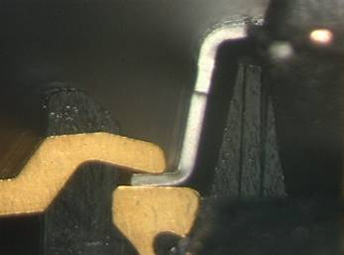
The burn-in QFN socket contacts the QFN terminal with a contact to provide an electrical connection. There are two types of contacts: a type that two contact the lead and a probe pin type that pierces the lead. For the open top socket, we provide a design that emphasizes contactability by a sandwiching structure (two-point contact), a cleaning function for the contact pin contact surface, and a solution that reduces solder debris such as prevention of impurity accumulation due to the step between the bottom pin and the resin surface. I have.
Enplas Semiconductor Equipment Co., Ltd., which operates IC Socket Solution.com, also provides heat dissipation solutions for heat-generating PKG.
Key points for selecting a QFN socket for burn-in Points
For burn-in QFN sockets, it is necessary to select the optimum specifications depending on the usage method, usage environment, and important functions. Here, we will introduce the important points in determining the specifications of the QFN socket for burn-in.
Point#1
Select either open top or clamshell from the method of setting the device
Point#2
Select the mounting method on the board by either focusing on contact reliability or focusing on maintainability.
Select the solder mounting method if you want to emphasize the contact reliability between the socket and the board, and select the surface pressure welding method if you want to emphasize maintainability.
※Precautions
Solder mounting method: Emphasis on contact reliability It is a pin that makes contact with one contact point, and the pad is relatively large and the terminal pitch is 0.4 mm or more. In addition, QFN sockets are relatively inexpensive because they are mainly made of molded products.
Surface pressure welding method: Emphasis on maintainability The contactor of the QFN socket is a lower contact probe pin. Since the pin of this bottom contact probe pin can move vertically, it is resistant to deformation (warp) of PKG, and it is possible to support narrow pitch and multi-pitch by supporting some cut products. It can also support QFN with a terminal pitch of 0.4 mm or less.
Point#3
Consider methods for heat dissipation and large current depending on the characteristics of PKG
As a measure to prevent thermal runaway due to heat generation of PKG, consider a heat sink after performing heat generation simulation. If it is compatible with large currents, consider using a bypass pin.
Point#4
Select general-purpose socket or custom socket depending on the PAD arrangement of PKG
For standard PAD arrangements, choose from an inexpensive standard lineup, and for fine pitch / multi pitch, choose a custom socket that suits it.
Point#5
Select the best contactor by PAD material and PKG bottom
Our technical staff will select the optimum pin plating material and shape according to the PAD material, the height of the PAD surface with respect to the bottom of the PKG, and the PAD outer shape.
QFN socket for burn-in Common problems Issues
Since the QFN socket for burn-in needs to exhibit stable performance even in a harsh environment, it is necessary to incorporate measures to avoid troubles in advance by utilizing simulation technology. Here are some common problems you may have when using QFN sockets for burn-in and solutions to them.
Issues #1
Thermal runaway due to PKG's self-heating
Devices with high self-heating of PKG may cause thermal runaway during burn-in tests in high temperature environments. If this happens, you will not be able to perform a burn-in test.
Solutions
Utilize thermal analysis simulation and avoid it by installing the optimum heat sink!
Issues #2
I want to use up to the high frequency band even in burn-in
Devices that use QFN sockets may be required to support high frequencies even at burn-in. However, since the characteristics of normal contact pins do not correspond to the high frequency band, it is necessary to adopt contact pins that meet the required specifications.
Solutions
The solution is to use a low inductance pin specification (0.7nH @ 500MHz / GSG 0.35mm pitch)!
Issues #3
Repeated burn-in reduces device yield
For Au-plated contact pins, the base of the contact pin may be exposed as the burn-in process is repeated. If this happens, the tin plating on the PKG lead will be transferred and peeled off, and the contact between the socket (contact pin) and the device will be poor. As a result, the burn-in test will be NG and the yield with the device will decrease.
Solutions
Achieves a long life with contact pins that use ES plating!
QFN socket
Our QFN socket solution for burn-in Solutions
IC Socket Solutions.com offers IC socket solutions that apply a wealth of experience and simulation technology to all the challenges that arise when burn-in testing QFN.
-
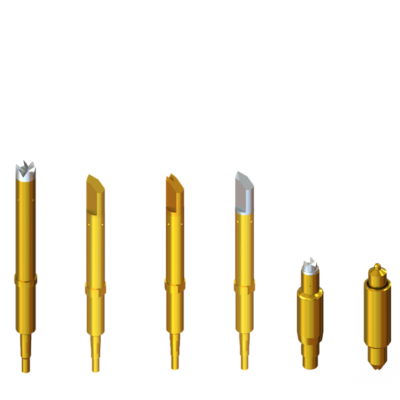
Spring Probe Pin
Enplas's own design will provide internal short circuit of probe pin with low resistance value (Ave 50m ohm or under)
Enplas provides suitable socket design proposal to meet required specification -
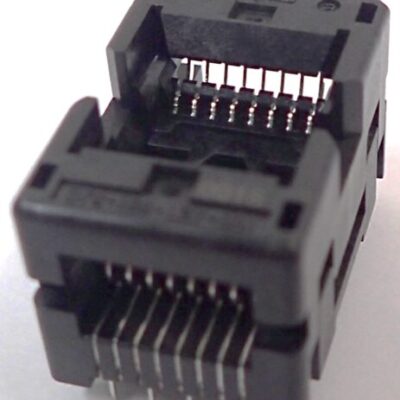
Non-magnetic Socket
Non-magnetic socket will be required for sensor application
Corrosion resistance with non-magnetic performance -
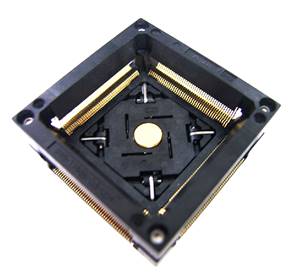
Open Top QFP/SOP pinch type socket
Pinch type contact (2-point contact) makes stable contact
Contact pin surface cleaning function prevents from accumulating debris due to the step between the bottom pin and the molded body surface. -
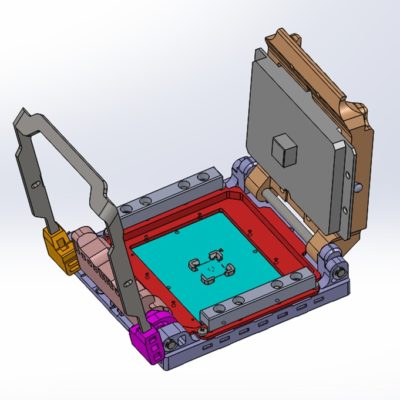
Custom socket for high power liquid cooling system
Not only BGA, and LGA, but also various type of package including QFN can be designed by using a socket that is suitable for the thermal head size
-

LCF series (general-purpose molded frame)
Low price and quick delivery for various devices up to 100mmx100mm
Replacible on site by surface mounting method -
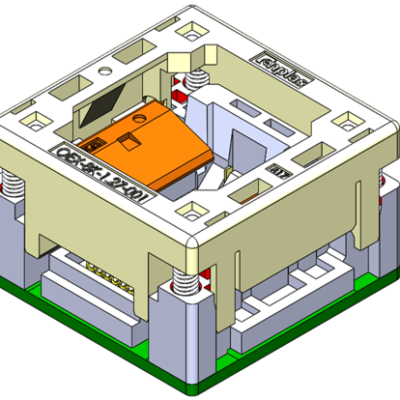
Sockets for power devices
Compatible with various power devices that are not handled by other companies
It is also possible to consider the optimum pin arrangement and support large currents of power devices. -
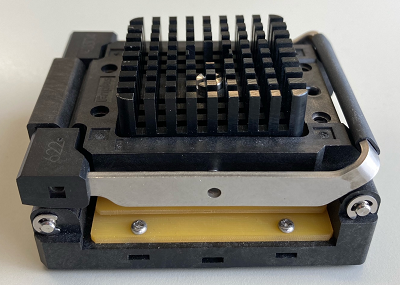
Socket with heat sink
Heat Sink will reduce the increase of device temperature by contacting device surface with this parts and radiating the device heat into the air.
-
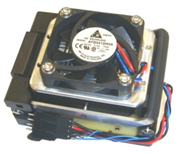
Individual Temparature Control System
Heater and temperature sensors can be attached to control the temperature of the device for each socket.
Achieves more accurate temperature control in comparison with general burn-in equipment (temperature setting ± 3 ° C) -
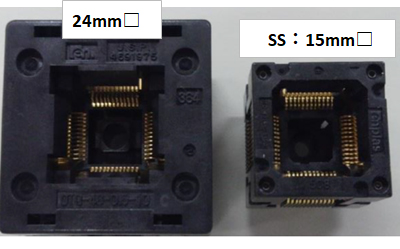
Super Shrink Socket
Increase of BIB density (1.8 times better density rate per 1 BIB)
In the condition of same socket qty, the reduction of BIB qty (45% reduction) -
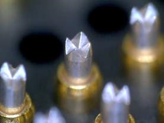
ES Plating
By developing special plating (ES plating), the life of burn-in socket contacts has been extended in high temperature environments.
Maintenance costs have also been significantly reduced by reducing re-gold plating costs, etc. -
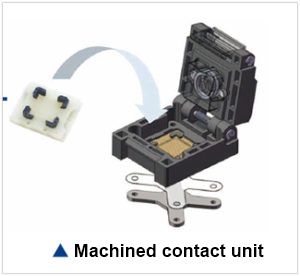
AM contact series
Low price and quick delivery for various devices by using machined Contact unit
Replacible on site by surface mounting method
Our QFN socket line up for burn-in Lineup
| Pitch | 3mm□ | 4mm□ | 5mm□ | 6mm□ | 7mm□ | 8mm□ | 9mm□ | 10mm□ | ||
|---|---|---|---|---|---|---|---|---|---|---|
| Through hole type | 0.4mm | 36pin | 40pin | 562in | 56pin | 68pin | 72pin | 88pin | ||
| 0.5mm | 20pin | 24pin | 36pin | 40pin | 56pin | 64pin | 68pin | |||
| 0.65mm | 12pin | 16pin | 24pin | 28pin | 40pin | 44pin | 52pin | |||
| Pitch | AM Pin | 10mm□ | 18mm□ | 23mm□ | 35mm□ | |
|---|---|---|---|---|---|---|
| Surface mount type | 0.35mm~ | shrink | #bg# | |||
| std. CS | #bg# | #bg# | ||||
| Type SS | #bg# | #bg# | #bg# | |||
| Type S | #bg# | #bg# | #bg# | #bg# |
| Pitch | 5mm□ | 6mm□ | 7mm□ | 8mm□ | 9mm□ | 10mm□ | |
|---|---|---|---|---|---|---|---|
| Through hole type | 0.4mm | 40pin | 64pin | ||||
| 0.5mm | 32pin | 36pin 40pin | 48pin | 56pin | 64pin | 68pin | |
| 0.65mm | 28pin | 32pin | 48pin |
Please feel free to contact us with
your questions regarding burn-in sockets.
Contact Us
- Is it possible to manufacture a socket with more than 10,000 pins?
- What kind of analysis can you provide ?
- Is there export to overseas and get local support?
- What should I do if there is a problem?
- What is the guaranteed cycle?
- What temperature can it be used in?
- I would like to consider a burn-in socket, but what information do you need?
- How long does it take to deliver?
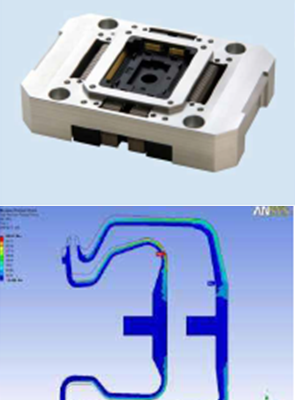
The test QFN socket is one of the test sockets that is required to have a long life and high current. When emphasis is placed on electrical characteristics, the short-length probe pin supports high current in the Kelvin test, and the hard Pd alloy also supports the long life of contacts. Probe Kelvin contact socket, high current support If you are looking for a press kelvin contact socket that achieves stable contact and long life with surface pressure contact type press contact pins. Since the press Kelvin contact socket is a surface pressure welding method, it is easy to replace the pin when it is worn out, making it ideal for mass production test applications.
Enplas Semiconductor Equipment, which operates IC Socket Solution.com, solves all the problems of QFN sockets for final testing.
Key points for selecting a QFN socket for testing POINTS
For the QFN socket for testing, it is necessary to select the optimum specifications according to the usage method, usage environment, and important functions. Here, we will introduce the important points in determining the specifications of the QFN socket for testing.
Point1
Select the optimum pin according to the required specifications and requirements
Select contact pin specifications according to specifications and requirements, such as probe pins when electrical characteristics are important, press pins when high current and high temperature are required, and press pins when price is important. To do.
Point2
If contact stability is important, adjust the pin tip shape and stroke amount.
Since the crown shape at the tip of the pin has more protrusions, the more the protrusions are, the more advantageous the contact is. Also, select a pin that can adjust the stroke amount according to the device.
Point3
Select the material of the contact pin tip according to the required durability
In order to improve wear resistance, carbon coating is applied to the tip of the contact pin, or the material of the tip of the pin is changed to palladium alloy or SK material to improve durability against wear or prevent Sn from adhering to the contact pin. It leads to the improvement of life and contact stability.
QFN socket for testing Common problems Issues
Since the QFN socket for testing needs to exhibit stable performance even in a harsh usage environment, it is necessary to incorporate measures to avoid troubles in advance by utilizing simulation technology. Here are some common problems and solutions for using test QFN sockets.
Issues #1
I want to improve the durability of the socket
Durability is important because the test QFN socket is used repeatedly. The standard contact pin is made of beryllium copper plated with gold, but if the pin tip is used repeatedly, wear and Sn adhesion will progress, and as a result, poor contact will easily occur.
Solutions
Avoid pin wear by using palladium plating and SK material!
The carbon coating avoids deterioration of contact due to Sn plating adhesion!
Issues #2
Cannot reliably evaluate micro signal characteristics
In the electrical characteristic test, it is necessary to confirm whether it works with a minute signal in particular, but it is not possible to reliably evaluate the minute signal characteristic because the increase in resistance value cannot be suppressed with a contact pin for a normal test socket.
Solutions
Can cancel the effect of contact pins on PKG characteristics
Uses Kelvin contact pin (probe press)
Issues #3
PKG dimensional variation is large and contact is not stable
QFN packages are prone to poor contact due to unstable positioning due to large dimensional variations. These package dimensional variations need to be absorbed by increasing the contact margin in the test QFN socket.
Solutions
Increase the margin with multi-point contact solution and solve contact failure!
Issues #4
I want a test socket that can handle large currents
In the case of QPN package, there are many cases where high current support is required, such as when 10 amperes or more are applied per pin, but normal contact pins do not support this. Therefore, it is necessary to select a contact pin that supports high current.
Solutions
Press-Kelvin contact socket for high current
Achieves stable contact and long life
QFN socket
Our QFN socket solution for Test Solutions
IC Socket Solution.com provides IC socket solutions that apply abundant achievements and simulation technology to all the problems that occur in the final test of ICs in QFN package.
-

Spring Probe Pin
Enplas's own design will provide internal short circuit of probe pin with low resistance value (Ave 50m ohm or under)
Enplas provides suitable socket design proposal to meet required specification -
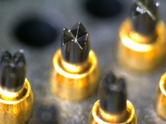
Conductivity Carbon Coating
Achieved a significant longer life of contacts by preventing solder migration
Achieved high durability with high slidablity and hardness -
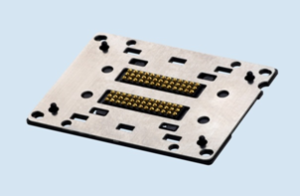
Capsule contact
The short-length probe pin structure (total length 1.5 mm) realizes good high-frequency characteristics.
Ideal for high-speed transmission and low-voltage products -

ES Plating
By developing special plating (ES plating), the life of burn-in socket contacts has been extended in high temperature environments.
Maintenance costs have also been significantly reduced by reducing re-gold plating costs, etc.
Our QFN socket line up for Test Lineup
| Pitch | Operation Temperature | Lifetime | Load | Contact Resistance | Current | |
|---|---|---|---|---|---|---|
| Press Kelvin | 0.4mm | -65℃~150℃ | 500,000 times | 45gf | 100mΩ | 8A |
| 0.5mm | ||||||
| 0.65mm | ||||||
| 0.8mm | ||||||
| 1.0mm | ||||||
| 1.27mm |
| pitch | Operation Temperature | Lifetime | Load | Insertion Loss/ Reflection Loss | |
|---|---|---|---|---|---|
| Capsule Pin | 0.5mm | -55℃ ~ +125℃ | 200,000 times | 25gf | >20GHz at -1dB / >20GHz at -10dB |
| 0.8mm | 250,000 times | ||||
| Probe Pin | 0.8mm | 200,000 times | |||
| 0.5mm | 200,000 times | ||||
| 0.4mm | 1,000,000 times |
Please feel free to contact us with
your questions regarding test sockets.
Contact Us
- Is it possible to manufacture a socket with more than 10,000 pins?
- Are there sockets for writing program data?
- What kind of analysis can you provide ?
- Is there export to overseas and get local support?
- What should I do if there is a problem?
- What is the guaranteed cycle?
- What temperature can it be used in?
- I would like to consider Enplas’s test socket. What kind of information I need to provide ?
- How long does it take to deliver?

